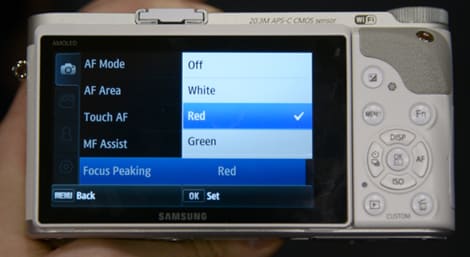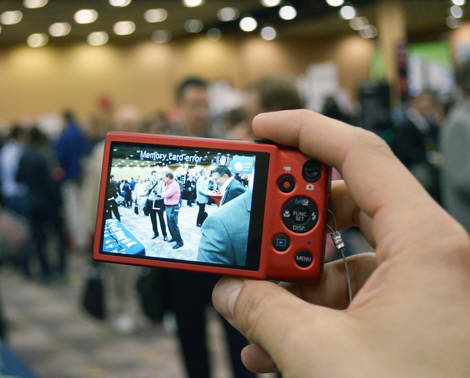Pros
Cons
Introduction
Design & Appearance
{{section_header}}{{section.name}}{{/section_header}}
The Panasonic DMC-FX78 is an attractive camera, slim and shiny, and available in multiple colors: silver, black, white, and pink.
Tour
{{section_header}}{{section.name}}{{/section_header}}




Ease of Use
{{section_header}}{{section.name}}{{/section_header}}
The Panasonic DMC-FX77 is easy to use, insomuch as there aren't too many options unless you really start digging for them. The entire interface is touch screen, and real estate on a screen is a valuable commodity – you don't want to cover up too much of the shooting area, so you cut down on on-screen data. If you have no aspirations towards learning the finer points of camera control, the FX77 should do you just fine.
The camera has an Intelligent Auto mode, or iA for short. In this mode, all you really need to do is point and click. The camera will do the rest.

The menu can be a bit of a slog because everything is limited by the speed and space usage of a touch screen interface. There are only so many options you can fit on the screen at one time, because your big, fat fingers need big, fat targets to tap. As a result, controls are buried in various menus and sub-menus, and it takes time to find what you're looking for. We don't love it, but Panasonic at least tries to keep things fun and cute through the use of a eye-catching icons rather than staid, old-style menus.

Size & Handling
{{section_header}}{{section.name}}{{/section_header}}
The Panasonic DMC-FX77 is an extremely compact camera, and will definitely fit in most pockets or bags. Measuring a mere 3.93 x 2.17 x 0.81 inches (99.7 x 55.2 x 20.55mm) and weighing just 0.32 lbs (142g), it's the very definition of a "go anywhere" camera.
Because it relies entirely on the touch screen, the handling is a far cry from a more fully realized camera. If you're accustomed to the speed that physical buttons and dials bring, be prepared to slow down. It's not that touch screens don't have their own strengths, but professional-type handling is not one of them.


Auto Mode
{{section_header}}{{section.name}}{{/section_header}}
The Panasonic DMC-FX78 has an Intelligent Auto mode, labeled "iA" in the menu, that is the easiest mode in which to shoot. When in iA, the menu options are blessedly limited to turning the flash on or off, get a 2 or 12-second shutter delay, change the photo resolution, and turn burst/drive mode on or off. The camera will take care of the exposure, white balance, and the rest automatically.

Movie Mode
{{section_header}}{{section.name}}{{/section_header}}
The Panasonic DMC-FX78 records video at a maximum resolution of 1080i (1920 x 1080 at 60 interlaced fps), and saves it in the AVCHD format at 17Mbps. You also have the option of 720p (1280 x 720) in either AVCHD or Motion JPEG. Because the lens and sensor are a bit more limited on the FX78, you probably shouldn't expect the same video quality you'd get from a high-end dedicated video camera, but the samples we shot on the CP+ show floor were pretty good.
Playback Mode
{{section_header}}{{section.name}}{{/section_header}}
The playback mode on the Panasonic DMC-FX78 allows multiple sort options, including the creation of in-camera albums. You can also perform some editing in-camera, including the fun (and bizarre) Makeup Retouch feature, detailed on the next page. The camera also has an option for slicing video clips into smaller segments.
Custom Image Presets
{{section_header}}{{section.name}}{{/section_header}}
The Panasonic DMC-FX78 has a slew of custom image presets, enough to cover a wide and esoteric array of shooting environments. If you leave the camera in auto mode, it can automatically detect and enable Portrait, Scenery, Night Portrait, Night Scenery, Sunset, and Macro scene modes.
You can manually choose from the following: Portrait, Transform, Self-Portrait, Scenery, Panorama Assist, Sports, Night Portrait, Night Scenery, Handheld Night Shot, Food, Party, Candle Light, Baby1, Baby2, Pet, Sunset, High sensitivity, Hi-Speed Burst(Image priority / Speed priority), Flash Burst, Starry Sky, Fireworks, Beach, Snow, Aerial, and Photoframe. If you can't find the right setting among all of these, you'd better just learn how to adjust exposure yourself.
Finally, there are also color modes for Standard, Natural, Vivid, Black & White, Sepia, Cool, and Warm.
Drive/Burst Mode
{{section_header}}{{section.name}}{{/section_header}}
The burst mode on the Panasonic DMC-FX78 is not particularly robust. At full resolution, it can only do about 3.7 frames per second, for a max of 7 photos. In high-speed burst mode, it can run at 6 or 10 frames per second, but at reduced resolutions.
Other Modes
{{section_header}}{{section.name}}{{/section_header}}
Like the new Lumix ZS10, the FX78 can record 3D images. They're not very good, and you need a 3D TV to actually see them, but we'll give you the run-down anyway. When you put the camera in 3D mode, a prompter instructs you to hold down the shutter button and slowly pan the camera from left to right. It will record 20 photos, then automatically pick the best two and create a composite 3D image in the MPO format. To view them, you can plug an HDMI 1.4 cable into any 3D TV, or pop the media card into a Panasonic 3D TV's card slot. It's certainly an interesting idea from a cross-marketing standpoint, and as a technological experiment, but it's not a useful feature.
Manual Controls
{{section_header}}{{section.name}}{{/section_header}}
The Panasonic DMC-FX78 has a few manual controls, but most of them focus around turning automatic features on or off. There are few "traditional" controls like shutter or aperture. This is probably good, considering the touch screen interface doesn't invite a lot of micromanagement of image quality.

Focus
{{section_header}}{{section.name}}{{/section_header}}
You cannot manual focus the picture, but there are multiple options for changing the AF Metering: Face, AF Tracking, 23 point, 1 point, Spot, and Touch Area. The Touch Area seems to take best advantage of the touch screen interface. You simply tap where you want to focus, and the camera does the rest.
You can also enable a macro focus feature for close-up shooting.
ISO
{{section_header}}{{section.name}}{{/section_header}}
The Panasonic DMC-FX78 offers ISO options for 100, 200, 400, 800, or 1600. There's also a High Sensitivity mode that automatically adjusts from 1600 to 6400.
Aperture & Shutter Speed
{{section_header}}{{section.name}}{{/section_header}}
The camera does not have a manual shutter speed option, but you can dictate the minimum shutter speed, with options for a minimum of 1/60, 1/30, 1/15, 1/8, 1/4, 1/2, or 1 second.
White Balance
{{section_header}}{{section.name}}{{/section_header}}
You can adjust the white balance to Auto, Daylight, Cloudy, Shade, Incandescent, or manual white balance set.
Exposure & Metering
{{section_header}}{{section.name}}{{/section_header}}
The Panasonic DMC-FX78 allows you to to shift the exposure compensation by +/-2 in 1/3EV stops. There is no direct control over the aperture. There is only one method of metering, called Intelligent Spot.
Image Stabilization
{{section_header}}{{section.name}}{{/section_header}}
The Panasonic DMC-FX78 has a Mega O.I.S. (optical image stabilization) that seems to do a great job with reducing blurriness. We gave the camera some vigorous shakes while we played with it on the CP+ show floor, and most of the picture came out sharp. There is also a separate mode for video recording.
Picture Quality & Size Options
{{section_header}}{{section.name}}{{/section_header}}
You can set the picture quality at 12.1MP, 8MP, 5MP, 3MP, 2MP, or 0.3MP. There are also options for selecting the aspect ratio to : 4:3, 16:9, 3:2, or 1:1.
Picture Effects
{{section_header}}{{section.name}}{{/section_header}}
Other Controls
{{section_header}}{{section.name}}{{/section_header}}
The Panasonic DMC-FX78 offers an Intelligent Contrast that sharpens the edges of high contrast areas. There's also a skin tone feature that works by finding skin tones and bumping them up a notch warmer or a notch cooler. Unlike Makeup Retouch, this mode takes place before you hit the shutter button.
LCD
{{section_header}}{{section.name}}{{/section_header}}
The LCD on the Panasonic DMC-FX77 is a touch screen, measuring 3.5 inches, and takes up the entire back of the camera. Unlike some of the more expensive Panasonic cameras, the resolution is only 230,000 pixels. It's enough to get the job down, but make fine focusing decisions may be out of the question (not that the camera really has much in the way of manual focus).

Flash
{{section_header}}{{section.name}}{{/section_header}}
The Panasonic DMC-FX77's flash is built into the front of the body. It can be set to auto, forced on, off, red eye reduction, or slow sync.

Lens & Sensor
{{section_header}}{{section.name}}{{/section_header}}
The Panasonic DMC-FX77 has an f/2.5 lens with a 5x optical zoom. It extends about 1.5 to 2 inches from the body when fully zoomed.

Jacks, Ports & Plugs
{{section_header}}{{section.name}}{{/section_header}}
The Panasonic DMC-FX77 houses a mini USB and mini HDMI on the side, and a card slot and battery slot on the bottom. Because the camera's so thin, the port covers are also quite slender.


Battery
{{section_header}}{{section.name}}{{/section_header}}
The battery that comes with the Panasonic DMC-FX77 is a thin Li-ion rechargeable that's rated for about 200 pictures.

Memory
{{section_header}}{{section.name}}{{/section_header}}
The Panasonic DMC-FX77 uses SD, SDHC, and SDXC cards for its primary memory. There's also a 70MB internal storage, but that will only hold so many pictures. Better to rely on that as an emergency back-up.
{{product.manufacturer_specs['FI Memory Photo']}}
Conclusion
The Panasonic Lumix DMC-FX78 strips away all those pesky camera controls like shutter and aperture control, and focuses on the important things, like retouching the makeup on your subject. That, in a nutshell, should give you a sense of this camera. It's definitely not the choice for an SLR shooter that's looking for a simple pocket cam – it's just too simple for that user. Rather, it could make a great choice for someone that wants a camera in their pocket, and is comfortable leaving it in auto mode 99% of the time. It's the party cam, the teenager cam, the club cam, and (if the marketing is to be believe) the lady cam. We can't attest to the the picture quality yet, but the all touch screen interface certainly slows down the user experience. We had a tough time finding the options we wanted, and missed the physical controls of a camera like the Lumix ZS10.
Sample Photos
{{section_header}}{{section.name}}{{/section_header}}
Specs
{{manufacturer_specs_table}}
Meet the tester
David Kender oversees content at Reviewed as the Editor in Chief. He served as managing editor and editor in chief of Reviewed's ancestor, CamcorderInfo.com, helping to grow the company from a tiny staff to one of the most influential online review resources. In his time at Reviewed, David has helped to launch over 100 product categories and written too many articles to count.
Checking our work.
Our team is here to help you buy the best stuff and love what you own. Our writers, editors, and experts obsess over the products we cover to make sure you're confident and satisfied. Have a different opinion about something we recommend? Email us and we'll compare notes.
Shoot us an email